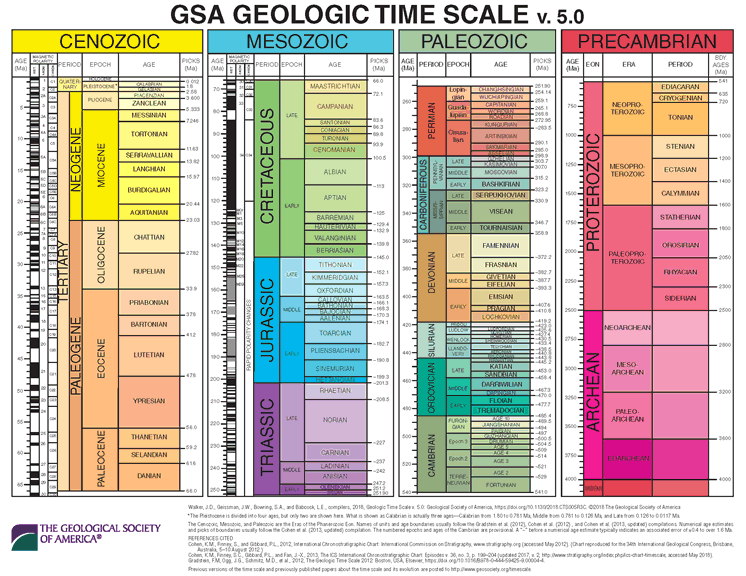Geologic time scale
The geologic time scale is the stratigraphic history of the Earth. Stratigraphy, also called chronostratigraphy is the ordering and analysis of the layers of the Earth (also called strata) based chronological dating techniques and the layers' positions relative to each other. Geologic time begins approximately 4.6 billion years ago, shortly after when the Earth began to form. [1]
The definitive geologic time scale chart is created by the International Commission on Stratigraphy (ICS, see Figure 1). The Commission is considered the foremost authority on geologic time. Its central purpose is to "precisely define global units (systems, series, and stages) of the International Chronostratigraphic Chart that, in turn, are the basis for the units (periods, epochs, and age) of the International Geologic Time Scale; thus setting global standards for the fundamental scale for expressing the history of the Earth."[1] The ICS time scale is the basis for all other geologic time scales that are created, such as the Geological Society of America's chart (GSA, see Figure 2).[2]
Units of Time
The geologic time scale is divided into several magnitudes of units of time:[1]
- Eons, or Eonothems, are the largest division of time, lasting thousands of millions of years. There eons are: the Phanerozoic (current eon) and the Precambrian eons of the Proterozoic, Archean, and Hadean.
- Eras, or Erathems, are the subdivisions of eons. They are more on the scale of hundreds of millions of years. The eras are: Cenozoic; Mesozoic; Paleozoic; Neo-, Meso-, and Paleo-proterozoic; and Neo-, Meso-, Paleo-, and Eo-archean.
- Periods, also referred as "systems", are the subdivisions of eras and typically last tens of millions of years. Some of the more famous epochs include the: Quaternary (current epoch), Cretaceous, Jurassic, Triassic, and Devonian.
- Epochs, also referred to as "series", are the subdivisions of periods. Epochs tend to be a several million years in length. The current epoch is the Holocene. Many epochs are simply titled "Upper", "Middle", or "Lower" along with their period name (e.g. the Upper Triassic). "Upper" refers to the youngest part of the period and "Lower" refers to the oldest part of the period.
- Ages, also referred to as "stages", are the smallest units of geologic time, and are usually only a few million years in length. The present age is the Meghalayan.
How the division dates are decided
The division dates of the various eons, eras, periods, epochs, and ages are based on a range of event types. These event types include, but are not limited to:[3]
- The first appearance of a species - this applies to all life forms (plants, animals, bacteria, etc). Of particular interest are species that are the "first of first" (e.g. the first oxygen breathing organism, the first seed producing plant, and so on).
- Extinctions - the extinction of key species or mass extinctions. Mass extinctions are events where a large number of species become extinct in a short amount of geologic time. A widely known example of a mass extinction is the Cretaceous-Paleogene extinction event, when the majority of dinosaur species became extinct.
- Major global climate shifts - when the climate changes drastically from the normal of the time period, such as when ice ages occur.
- The formation and/or separation of supercontinents - Supercontinents form when all major landmasses on the Earth's surface come together as one landmass.
- Catastrophic events - Large-scale catastrophic events can cause or trigger other events such as climate changes and extinctions. Catastrophic events are events like major volcano eruptions, meteorite impacts, and major floods.
- Shifts in global magnetic polarity - the magnetic polarity of the planet "flips" on an irregular basis, with the North pole becoming the South pole and vice versa.

The specific dates of events and boundaries are determined using techniques such as radioactive dating and geologic principles.
For Further Reading
- Holocene
- Stratigraphy
- Climate
- Time scale of the universe
- Geology
- Or explore a random page
References
- ↑ 1.0 1.1 1.2 1.3 International Commission on Stratigraphy."International Chronostratigraphic Chart v2018" Accessed Nov.2, 2018 [Online]. Available: http://www.stratigraphy.org/index.php/ics-chart-timescale
- ↑ 2.0 2.1 Geological Society of America."GSA Geologic Time Scale" Accessed Nov.2, 2018 [Online]. Available: https://www.geosociety.org/images/gsa/timescale/timescl-2018.gif
- ↑ F.M. Gradstein, J.G. Ogg, and A.G. Smith."Construction and summary of the geologic time scale" Accessed Nov.2, 2018 [Online]. Available: http://basin.earth.ncu.edu.tw/download/courses/sequence_strat/reading/chap1/Introduction%202.pdf

